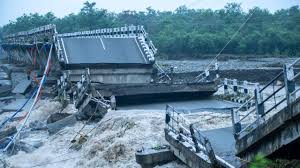Syllabus:
GS1: Important Geophysical phenomena such as earthquakes, Tsunami, Volcanic activity, cyclone etc., geographical features and their location- changes in critical geographical features (including water bodies and ice-caps) and in flora and fauna and the effects of such changes.
GS3: Conservation, environmental pollution and degradation, environmental impact assessment
Context:
The recent catastrophic floods in the Himalayas, particularly in Himachal Pradesh and Uttarakhand, underscore a grim reality: such extreme weather events are becoming more frequent and severe.
More on the News
- The recent disaster was not unexpected; it had been long anticipated through scientific studies, community experiences, and ecological warnings.
Causes of the Disaster
Climate Change Impacts:
- Accelerated Warming: The Western and Central Himalayas are warming at nearly twice the global average (1.8°C in 50 years), leading to rapid glacial melt.
- Erratic Weather Patterns: This warming results in increasingly erratic rainfall, including violent monsoon bursts.
- Glacial Lake Outburst Floods (GLOFs) Risk: Rapid glacial retreat increases the threat of sudden outbursts from glacial lakes. The eastern Himalayas have been witness to a major GLOF – the 2023 Sikkim disaster.
- Committed Warming: Past industrial emissions have locked in “committed warming,” leading to irreversible climate consequences that are already being experienced (2022 and 2023 IPCC reports).
Unsustainable Anthropogenic Activities:
- Destructive Infrastructure Development: Hydropower projects and highway construction involve blasting riverbeds and crude cutting into unstable slopes, destabilizing the fragile ecosystem.
- Unregulated Tourism: Mass tourism contributes to environmental degradation through plastic waste, damaged trails, and overall ecological imbalance, rather than benefiting the region sustainably.
Institutional Gaps and Implementation Failures:
- Lack of Actionable Plans: State Disaster Management Authorities (SDMAs) in Himachal and Uttarakhand produce comprehensive reports with hazard maps and strategic frameworks, but these often remain theoretical “paper-bound intentions.”
- Absence of Execution: These reports frequently lack clear executable timelines and dedicated budgets, hindering effective disaster preparedness and mitigation.
Impact of climate change on the Himalayas
- Loss of Life and Livelihoods: Devastating human casualties, displacement, and destruction of agricultural land and homes.
- Economic Setback: Significant damage to infrastructure, tourism industry, and agricultural sector, leading to long-term economic recovery challenges.
- Environmental Degradation: Increased soil erosion, loss of biodiversity, and disruption of delicate Himalayan ecosystems.
- Social Disruption: Breakdown of essential services, psychological trauma, and increased vulnerability of marginalized communities.
Way Forward
- Homes and hamlets must be reconstructed atop engineered terraces — elevated, buttressed by stone retaining walls, and supported by deep-rooted grasses that anchor the soil.
- As for the roads that slice across hillsides, less than 30% adhere to basic slope drainage codes.
- Build infrastructure that is flood-adaptive by design.
- Disaster mitigation agencies must move from planning to implementation, with funds, audits, and accountability.
- Preparedness must become a daily civic routine.
- We must restore a material spirituality, one that regards the Himalayas not as a resource bank, but as a living cosmos.
Source: The Hindu
https://www.thehindu.com/opinion/op-ed/himalayan-floods-are-here-to-stay/article69812395.ece

